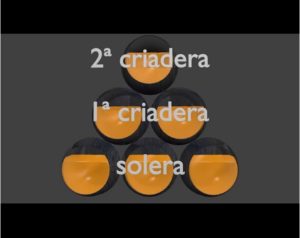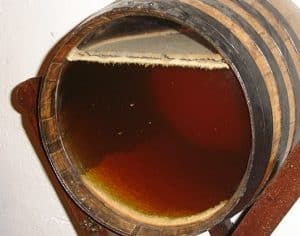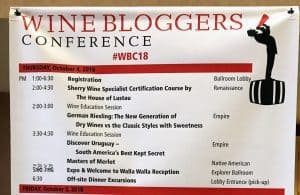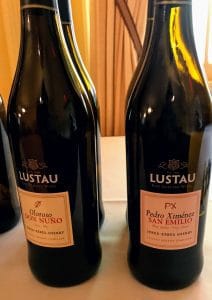“It is what we think we know that keeps us from learning.” — Chester I. Barnard

What I love about wine is that I’m never going to master it. Not even going to come close.
Of course, I’m going to work my butt off to finish my WSET Diploma. After that, perhaps I’ll become a Master of Wine candidate and hopefully earned those MW initials. But even then, the kindling that stokes my wine passions will continue to be the vastness of everything I don’t know.
Perhaps that’s why I get a perverse thrill in realizing that I’ve had something wrong for so many years. More logs for the fire.
And boy did I have a lot of things wrong about the solera system used in Sherry!
Or, rather, I had a very simplistic understanding of it. I knew enough to be dangerous. I had a solid idea of what fractional blending was and why it was done.
Like most wine geeks, I could sketch out that familiar pyramid of barrels. I understood–or at least thought I understood–how the bottom of the solera is never wholly emptied. All the wine pulled for bottling is replaced by the layer above it. Then that layer is refilled from what’s above it until we get to the top layer with the new harvest’s wines.
But that knowledge is about as dangerous as a butter knife.
Clearly, I needed a few whetstones. I found them in my Diploma textbook as well as Julian Jeffs’ Sherry and Ruben Luyten’s phenomenal website Sherry Notes.
Mythbusting #1 – There are no pyramids of barrels.

Also, barrels are heavy and it’s not practical to have more than 3-4 layers stacked on top of each other.
Take that classic graphic you see everywhere and chuck it out the window. The reality is that each layer (a criadera or scale), is almost always grouped together and kept separate from the other layers. Sometimes they’re even kept in different bodegas. This is done for several reasons.
One consideration is insurance against a catastrophe. Something like a fire in one part of the barrel room or a bodega could take out a whole solera system. Yes, losing an entire criadera itself would be terrible (especially if it is the oldest solera layer). However, that’s nowhere near as devastating as losing all the scales at once.
But there’s also an overlooked winemaking reason as well.
Wines mature differently in different areas. This is true on a macro scale of one bodega in Sanlúcar de Barrameda and another in El Puerto de Santa María–as well as two bodegas across the street in Jerez. But it’s also exhibited on a micro-level between two corners of the same barrel room.
It can even be seen in the difference within a stack of 4 layers of barrels. The bottom two layers, closest to the floor, are always going to be cooler as heat rises. This means that the upper layers will mature faster and experience more evaporation–increasing the concentration of alcohol, body and flavor.
If you’re knowledgeable about whiskey, that’s going to sound awfully familiar. As in Sherry, whiskey producers know that barrels in various parts of the rack house or dunnage warehouse mature differently.
This variance adds complexity and more color to a master blender’s palette. An experienced capataz (cellarmaster) is always keenly aware of the unique terroir in their bodegas. They will spread out the various scales of their soleras to different areas with the right conditions they’re looking for.
Mythbusting #2 – The solera layer isn’t always on the floor either.
The last or oldest scale of a solera is called, somewhat confusingly, the solera layer. This comes from the Spanish suelo and Latin solum which means “floor”. So, of course, all those pyramid schematics feature this layer at the bottom.
But more often you’re going to find younger criadera of Finos and Manzanilla on the actual bottom floor layer. Here they can take advantage of the cooler temperatures and slower maturation. Stacked on top of them might be criadera from a completely different solera of oxidatively aged Amontillado or Oloroso. It makes more sense to put these barrels here since they will benefit from the warmth.
Mythbusting #3 – They’re not partially emptying one barrel into another barrel on the next level.
Now while bodegas want complexity, one overarching theme to remember about a solera is that its primary purpose is to ensure consistency. As we noted above, barrels mature differently. So even two barrels right next to each other could develop unique personalities. That variance isn’t a bad thing, but producers need to control it somehow.
For example, if you’re pulling from Barrel A in criadera 4 to refill Barrel B in criadera 3, then any and all barrel variation exhibited by Barrel A will only be shared with just Barrel B. This is going to compound, rather than smooth out, barrel variations. When you’re aiming for consistency, that’s not good. This is why the rocío (replenishing wine) is hardly ever transferred just straight barrel-to-barrel.
Instead, the wine removed from Barrel A is going to be divided up between multiple barrels in criadera 3 (B, C, D, E, F, etc.). The video below (1:29-2:20) shows this old-school method. The more modern, mechanized technique is to remove all the saca (wine being pulled) from the various barrels in one criadera and mix them in a tank. Then this blended rocío is evenly portioned out to refill all the barrels of the older criadera.
Mythbusting #4 – It’s not like racking with just pouring the new wine back into the barrel.
Many wine geeks are familiar with what racking is. It’s an easy image to picture taking place in the solera. But you have to remember that with Sherry–particularly biologically aged Finos and Manzanilla–there’s a hitch. You don’t want to disturb the flor.
This is especially vital since another essential purpose of a solera is to sustain a healthy flor by frequently reintroducing fresh wine and nutrients for the yeast.
Therefore you need specialized tools for both the saca and rocío. These tools, the sifon and rociador, dive underneath the layer of flor–but not too deep to disturb the lees at the bottom of the barrel. I mentioned this Jamie Goode video in my post on the Top 5 YouTube Videos on Sherry Wine, but it’s worth revisiting to see these tools in action.
Mythbusting #5 – The new harvest doesn’t go straight into a solera.
It seems so simple, right? You finish fermentation of the new year’s wine, put it into barrel and boom. You’ve got the new baby wine layer for the solera. Ready to go.
Not quite.
The new harvest, añadas or vintage wine, needs to first go through a waiting period. During this time the wine is monitored to see what style it lends itself too. Most wine geeks are aware of an initial first classification where barrels are chalked up as “palma/palo” for lighter styles designated for biological aging or “raya/gordura” for more robust wines destined for oxidative styles. It is at this stage where fortification happens to either encourage flor (15-15.5% ABV) or prevent it from developing (17%).
But the wines aren’t shuttled off to join a Fino or Oloroso solera just yet. Instead, the barrels continue to be observed as part of the sobretablas. This can last anywhere from 9 months to 2 or 3 years. Sometimes even longer. With Finos and Manzanillas, the development and health of the flor are monitored with some barrels getting diverted towards more oxidative styles like Amontillado. For potential Oloroso and Palo Cortado, the body and texture are evaluated. It is this second classification that ultimately determines which solera the wine will be best suited for.
Mythbusting #6 – Likewise, the new harvest isn’t always what goes into the youngest criadera.

From the Dutch Wikipedia.
Many established soleras, particularly those producing VOS/VORS wines, aren’t replenished by the new year’s wines. Instead, the source for their “new blood” is the already aged products from other soleras.
The reasons for this are quality driven but also quite practical. It requires an immense amount of time to start a solera from scratch with new vintage wines. For very old Sherries, it makes more sense to start and sustain them with wine that has already been significantly aged.
This is also the case with many Amontillados. Producers often will take wine from an established Fino or Manzanilla solera to replenish an Amontillado system. Many Palo Cortados (such as Valdespino’s Viejo C.P.) are made by selecting high-quality barrels from Fino and Amontillado soleras and then feeding them into the Palo Cortado solera. Rarely is a Palo Cortado solera replenished by a new vintage’s wine.
Before busting this myth, I use to wonder why things like a VORS (30+ year aged Sherry) solera didn’t have 30+ scales of barrels. This was driven by my mental-math quandary with the next myth.
Mythbusting #7 – Bottling doesn’t happen once a year.
The input-output of a solera didn’t always add up for me. It especially seemed complicated by the fact that Sherry producers couldn’t legally drain more than 30% of a barrel for bottling. Factoring loses from evaporation helped the mental math a little. In large soleras, 1 to 2 barrels worth of wine could be lost between criadera levels from the angel’s share. But I always knew that there were some puzzle pieces I was missing.
Learning that soleras are dynamic with barrels moving between different soleras filled in a few of those pieces. But I had to divorce my thinking from the traditional winemaking calendar of bottling a particular wine once a year. Unlike many wines, Sherry is bottled on-demand to meet the needs of the market.
In the case of Finos and Manzanillas, there could be 2-4 or even 6+ bottlings a year.

To maintain a healthy amount of flor, Fino and Manzanilla soleras need regular replenishment from more frequent bottlings.
This ensures that the wine that hits the market is fresh. However, it also helps sustain the vital flor with frequent replenishment of new wine being brought in from the sobretabla. Keep in mind, those producers don’t have to bottle the maximum amount they’re legally able to pull. The saca may only be 10-20% of each barrel or even 5%. Again, depending on the demand of the market.
There doesn’t even have to be any bottling in a given year. This is especially pertinent if there aren’t the sales to warrant putting more bottles out in the market. The wine will just sit there chilling in the solera until there is a need to bottle more. This flexibility to weather dips and booms in demand has been critical in Sherry’s survival.
However, the final piece to my mental math puzzle was the realization that I had to throw the math away. Because…
Mythbusting #8 – The oldest solera layer isn’t always the scale that a Sherry is bottled from.
This was my “son of a bitch” light bulb moment while studying. It was at this point when I realized how spectacularly wrong I was with my thinking about how soleras work. Again, I have to blame those classic pyramid illustrations. They evoke the image of Sherry wine flowing through the criaderas of a solera like a river. The wine enters in as headwaters only to eventually exit into the ocean–bottled and sent out into the world.
But the truth is, the layers of criadera are like ports along the river. Here the wine can be diverted away as irrigation channels to meet price points and stylistic demands.
Legally, a Sherry only has to be at least two years old to be bottled and sold as Sherry. Many times, it’s already reached this minimum at the sobretabla phase. So at any point, with any layer of the solera, a producer can selectively pull wine out to blend and bottle. It doesn’t have to be from that oldest solera layer at all.

There is great flexibility in being able to blend and pull from multiple scales of a solera. This allows bodegas to produce Sherry in a variety of styles to meet various price points.
For example, let’s say a producer is making a fairly inexpensive and light Sherry.
The bulk of that wine is likely going to come from young criaderas. It wouldn’t make stylistic or economical sense to pull it from the oldest layer. Though, the producer may pull a little bit from one of the older scales to add complexity. Likewise, even a premium Sherry bottled from older criadera levels may need some wine from younger scales for added freshness.
Of course, there are many Sherries that are bottled exclusively from that oldest solera level. But it doesn’t have to be that way. In many respects, all the various criadera layers are essentially like “reserve wines” in Champagne. Bodegas can selectively pull and blend between them to make multiple Sherries of all different price points and styles.
So, yeah, those pyramid drawings of Sherry that you see everywhere are pretty wrong.
However, they are the most straightforward way of trying to boil down a very complex and dynamic system. It’s not that they’re entirely misleading. They’re just very incomplete.
Realizing how lacking those illustrations are isn’t a reason to get annoyed. Instead, it should be a reason to appreciate Sherry more and get excited.
After all, there’s so much more out there to learn and discover.



